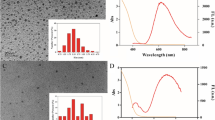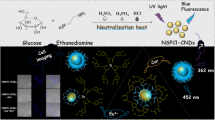Abstract
A series of dual-emission fluorescent probes was prepared from copper nanoclusters (Cu NCs) and carbon dots (CDs). They show two emission peaks (blue at 469 nm and red at 622 nm) when photoexcited at 365 nm. Upon exposure to sulfide, the Cu NCs will be deteriorated because they react with sulfide to form CuS. This results in the quenching of the red fluorescence of the Cu NCs, while the blue fluorescence of the CDs remains constant. Thus, the color of the nanocomposite changes from red to blue. The ratio of the fluorescences at the two wavelengths decreases linearly in the 2–10 ppb (26–128 nM) sulfide concentration range, and the limit of detection is 0.33 ppb (4.3 nM). The nanocomposite also was placed in an agar gel and then incorporated into a paper strip for fluorometric monitoring of gaseous hydrogen sulfide.

Schematic presentation of the synthesis of Cu NCs (copper nanoclusters)-CDs (carbon dots) dual-emission nano-assembly, Cu NCs-CDs-agar fluorescent film and their application for the detection of sulfide and H2S.






Similar content being viewed by others
References
Liu L, Chen Z, Yang S, Jin X, Lin X (2008) A novel inhibition biosensor constructed by layer-by-layer technique based on biospecific affinity for the determination of sulfide. Sensors Actuators B Chem 129:218–224
Eto K, Asada T, Arima K, Makifuchi T, Kimura HJB (2002) Brain hydrogen sulfide is severely decreased in Alzheimer's disease. Biochem Bioph Res Co 293:1485–1488
Yue X, Zhu Z, Zhang M, Ye Z (2015) Reaction-based turn-on electrochemiluminescent sensor with a ruthenium(II) complex for selective detection of extracellular hydrogen sulfide in rat brain. Anal Chem 87:1839–1845
Zhou T, Wang N, Li C, Yuan H, Xiao D (2010) Sulfide sensor based on room-temperature phosphorescence of PbO/SiO2 nanocomposite. Anal Chem 82:1705–1711
Liu B, Han S (2016) Determination of trace hydrogen sulfide by using the permanganate induced chemiluminescence of carbon dots. Microchim Acta 183:3087–3092
Wang C, Cheng H, Sun Y, Xu Z, Lin H, Lin Q, Zhang C (2014) Nanoclusters prepared from a silver/gold alloy as a fluorescent probe for selective and sensitive determination of lead(II). Microchim Acta 182:695–701
Wang X, Wu Q, Jiang K, Wang C, Zhang C (2017) One-step synthesis of water-soluble and highly fluorescent MoS2 quantum dots for detection of hydrogen peroxide and glucose. Sensors Actuators B Chem 252:183–190
Wu Q, Wang X, Rasaki SA, Thomas T, Wang C, Zhang C, Yang M (2018) Yellow-emitting carbon-dots-impregnated carboxy methyl cellulose/poly-vinyl-alcohol and chitosan: stable, freestanding, enhanced-quenching Cu2+-ions sensor. J Mater Chem C 6:4508–4515
Sun Y, Wang X, Wang C, Tong D, Wu Q, Jiang K, Jiang Y, Wang C, Yang M (2018) Red emitting and highly stable carbon dots with dual response to pH values and ferric ions. Microchim Acta 185:83
Wu J, Jiang K, Wang X, Wang C, Zhang C (2017) On−off−on gold nanocluster-based near infrared fluorescent probe for recognition of cu(II) and vitamin C. Microchim Acta 184:1315–1324
Ao H, Feng H, Li K, Zhao M, Qian Z, Chen J (2018) Coordinate bonding-induced emission of gold-glutathione complex for sensitive detection of aluminum species. Sensors Actuators B Chem 272:1–7
Su Y, Zhou X, Long Y, Li W (2018) Immobilization of horseradish peroxidase on amino-functionalized carbon dots for the sensitive detection of hydrogen peroxide. Microchim Acta 185:114
Wang X, Yang X, Wang N, Lv J, Wang H, Choi MM, Bian W (2018) Graphitic carbon nitride quantum dots as an “off-on” fluorescent switch for determination of mercury(II) and sulfide. Microchim Acta 185:471
Jin L, Zhang Z, Tang A, Li C, Shen Y (2016) Synthesis of yeast extract-stabilized cu nanoclusters for sensitive fluorescent detection of sulfide ions in water. Biosens Bioelectron 79:108–113
Wang C, Lin H, Xu Z, Huang Y, Humphrey MG, Zhang C (2016) Tunable carbon-dot-based dual-emission fluorescent Nanohybrids for Ratiometric optical thermometry in living cells. ACS Appl Mater Interfaces 8:6621–6628
Huang X, Jiang H, Li Y, Sang L, Zhou H, Shahzad SA, Ibupoto ZH, Yu C (2017) Synthesis of silica nanoparticles doped with [Ru(bpy)3]2+ and decorated with silver nanoclusters for the ratiometric photoluminescent determination and intracellular imaging of cu(II) ions. Microchim Acta 184:2325–2331
Song S, Zhang Y, Yang Y, Wang C, Zhou Y, Zhang C, Zhao Y, Yang M, Lin Q (2018) Ratiometric fluorescence detection of trace water in organic solvents based on aggregation-induced emission enhanced cu nanoclusters. Analyst 143:3068–3074
Yan Y, Zhang K, Yu H, Zhu H, Sun M, Hayat T, Alsaedi A, Wang S (2017) Sensitive detection of sulfide based on the self-assembly of fluorescent silver nanoclusters on the surface of silica nanospheres. Talanta 174:387–393
Song S, Wang C, Zhao Y, Hu T, Zhou X, Zhao T, Yang M, Lin Q (2018) Gold-cluster-based dual-emission nanocomposite film as Ratiometric fluorescent sensing paper for specific metal ion. Part Part Syst Charact 35(4):1700471
Jia X, Li J, Wang E (2013) Cu nanoclusters with aggregation induced emission enhancement. Small 9:3873–3879
Li Q, Zhou M, Yang M, Yang Q, Zhang Z, Shi J (2018) Induction of long-lived room temperature phosphorescence of carbon dots by water in hydrogen-bonded matrices. Nat Commun 9:734
Yu X, Zhang C, Zhang L, Xue Y, Li H, Wu Y (2018) The construction of a FRET assembly by using gold nanoclusters and carbon dots and their application as a ratiometric probe for cysteine detection. Sensors Actuators B Chem 263:327–335
Chen Y, Zheng M, Xiao Y, Dong H, Zhang H, Zhuang J, Hu H, Lei B, Liu Y (2016) A self-quenching-resistant carbon-dot powder with tunable solid-state fluorescence and construction of dual-fluorescence morphologies for white light-emission. Adv Mater 28:312–318
Chen TH, Tseng WL (2017) Self-assembly of monodisperse carbon dots into high-brightness nanoaggregates for cellular uptake imaging and iron(III) sensing. Anal Chem 89:11348–11356
Li CM, Ding SN (2015) Rapid, selective, and ultrasensitive fluorescence ratio-metric detection of sulfide ions using dual-emitting BSA-erbium (III)-modulated gold-silver bimetallic nanoclusters. Anal Methods 7:4348–4354
Aziz MA, Mahfoz W, Shaikh MN, Zahir MH, Al-Betar AR, Oyama M, Theleritis D, Yamani ZH (2017) Preparation of indium tin oxide nanoparticle-modified 3-Aminopropyltrimethoxysilane-functionalized indium tin oxide electrode for electrochemical sulfide detection. Electroanal 29:1683–1690
Zhou T, Wang N, Li C, Yuan H, Xiao D (2010) Sulfide sensor based on room-temperature phosphorescence of PbO/SiO2 nanocomposite. Anal Chem 82:1705–1711
Gong C, Gong Y, Oo MKK, Wu Y, Rao Y, Tan X, Fan X (2017) Sensitive sulfide ion detection by optofluidic catalytic laser using horseradish peroxidase (HRP) enzyme. Biosens Bioelectron 96:351–357
Magesh G, Bhoopathi G, Nithya N, Arun AP, Ranjith Kumar E (2018) Structural, morphological, optical and biological properties of pure ZnO and agar/zinc oxide nanocomposites. Int J Biol Macromol 117:959–966
Ding Y, Li X, Chen C, Ling J, Li W, Guo Y, Yan J, Zha L, Cai J (2017) A rapid evaluation of acute hydrogen sulfide poisoning in blood based on DNA-cu/ag nanocluster fluorescence probe. Sci Rep 7:9638
Zeng J, Li M, Liu A, Feng F, Zeng T, Duan W, Li M, Gong M, Wen C-Y, Yin Y (2018) Au/AgI dimeric nanoparticles for highly selective and sensitive colorimetric detection of hydrogen sulfide. Adv Funct Mater 28:1800515
Acknowledgments
This work is supported by Zhejiang Provincial Natural Science Foundation of China under Grant No. LY18E030010, and National Key Research and Development Program of China through grant 2016YFB0101200, 2016YFB0101205. Dr. C. Wang would like to thank for open project of state key laboratory of supramolecular structure and materials (sklssm201819). Dr. M. Yang would like to thank for the National “Thousand Youth Tal-ents” program of China and Ningbo 3315 program.
Author information
Authors and Affiliations
Corresponding authors
Ethics declarations
The author(s) declare that they have no competing interests.
Additional information
Publisher’s note
Springer Nature remains neutral with regard to jurisdictional claims in published maps and institutional affiliations.
Electronic supplementary material
ESM 1
(DOCX 1.08 mb)
Rights and permissions
About this article
Cite this article
Wen, Z., Song, S., Hu, T. et al. A dual emission nanocomposite prepared from copper nanoclusters and carbon dots as a ratiometric fluorescent probe for sulfide and gaseous H2S. Microchim Acta 186, 258 (2019). https://doi.org/10.1007/s00604-019-3295-y
Received:
Accepted:
Published:
DOI: https://doi.org/10.1007/s00604-019-3295-y




